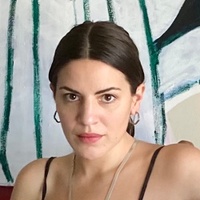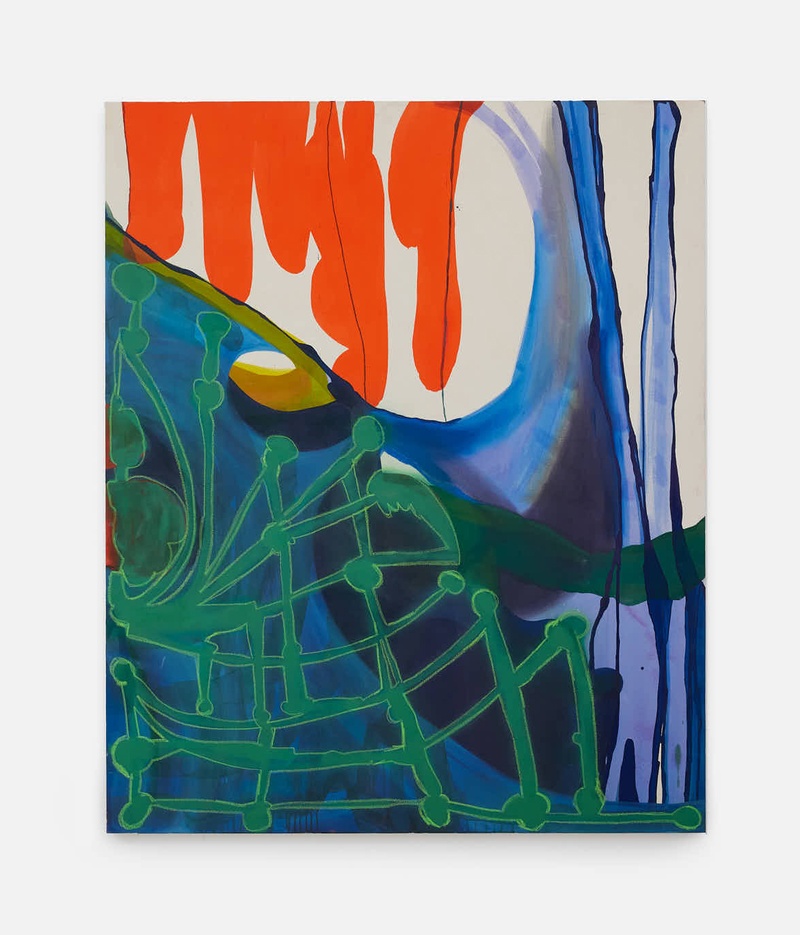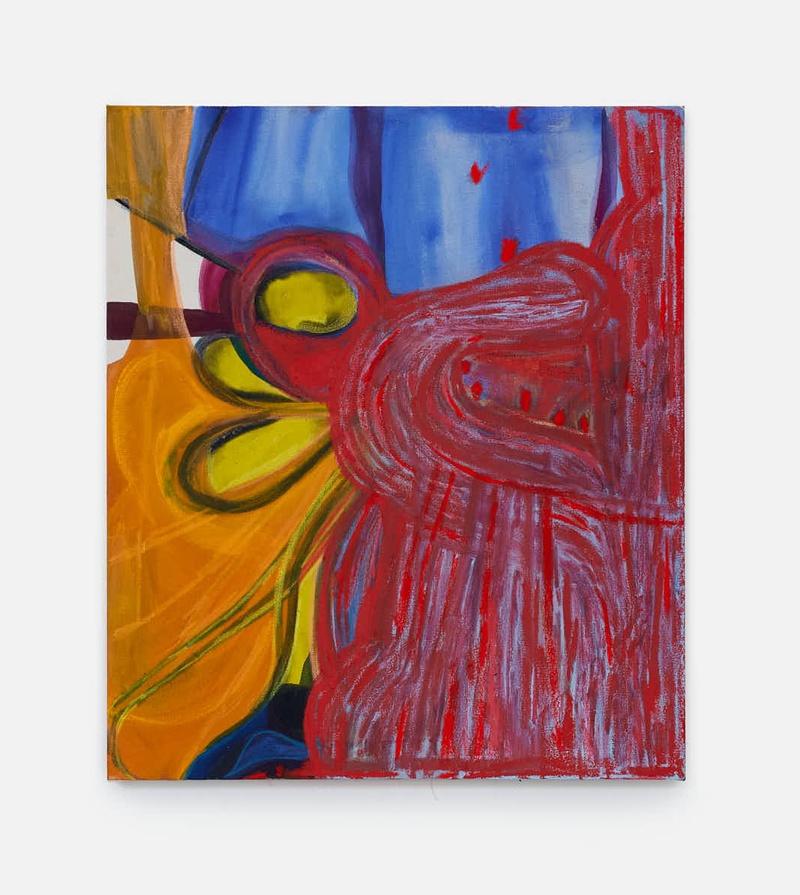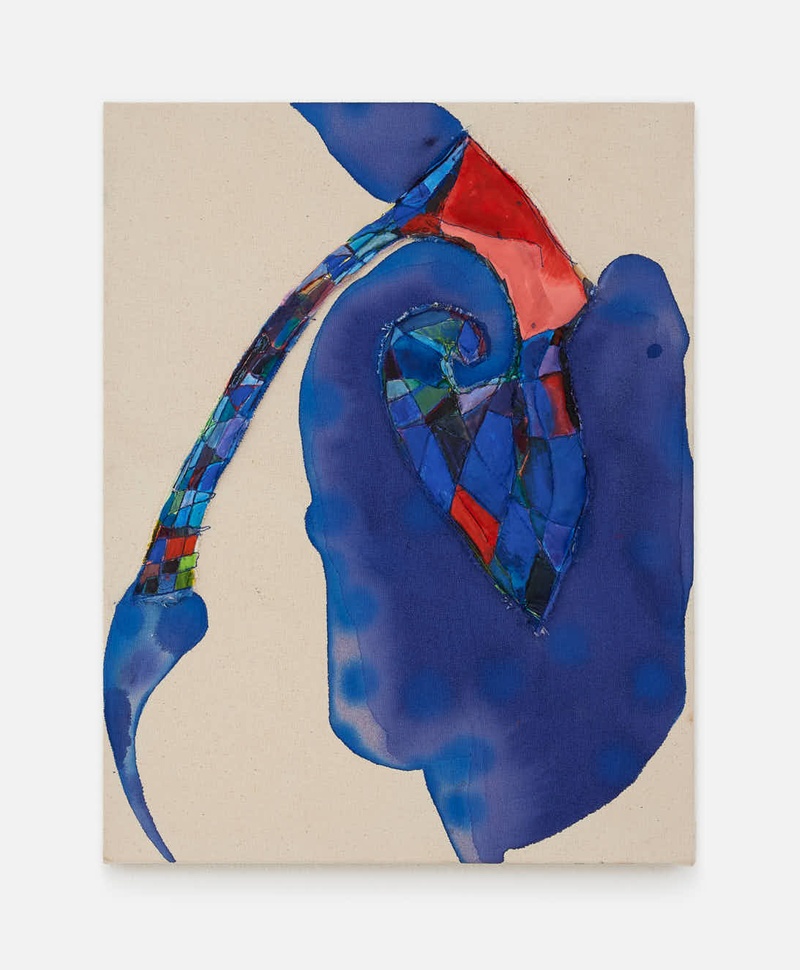As told to Robert Alan Grand, 1907 words.
Tags: Art, Performance, Time management, Focus, Inspiration, Process.
On the importance of honoring your ideas
Painter, writer, performer, and designer Annie Bielski on working intuitively, the push and pull between revealing and concealing, and learning to protect your time.My Gut, 2023. Acrylic, ink, marker, wax crayon, paracord, thread, on canvas. 55 x 66 in. Courtesy the artist and Rachel Uffner Gallery. Photo by Brad Trone.
You’re a painter, you’re a writer, performance artist, collaborator, facilitator, and designer. How do you balance the different facets of your practice?
Something I’ve been learning to do over the last couple of years is to embrace this. I don’t know that I have balance, but more like, I’m going with what I’m drawn to and trusting that it all makes sense for me and my work. There are some times when I look back and think, Wow, I focused a lot of time on this one particular project that I didn’t need to, and maybe I could have spent that energy elsewhere. But I also have this idea that even the “failure things,” or the “distraction things” that I do feed into the other projects.
I feel like when you’re in school or early in your career as an artist, there’s an emphasis on, “Pick one thing, one medium, and stick to it.” But like you’re saying, it all influences each other, bounces around in your head, and leads down a different road. It’s nice to hear you’re not afraid of that.
I will say, painting has been a thread throughout everything. There have been years where when I was doing more touring with [Norwegian singer-songwriter and collaborator] Jenny Hval in the US and Europe, and then I would come home and organize. I’d organize events, experimental comedy nights, all kinds of stuff like that. I wasn’t doing as much painting, but it’s always this thing that I return to and has always been there.
Video still, Jenny Hval ‘Year of Love.’ Directed by Annie Bielski, Jenny Berger Myhre, and Jenny Hval. 2022.
Your paintings are consumed with the body. They’re very physical. What about the body inspires you, and what impels you to work in this intuitive fashion?
When I was an undergrad, one of my instructors challenged me to make something at least as big as I was. That was so exciting. I realized my sense of scale, in making, is always related to my body. My physicality, how I relate to size, how I can move this work in my studio, and the viscosity of the materials I’m using. I do feel the most in myself when I’m in my painting studio and really in the flow.
The process of stretching canvas: it’s like skin, it’s clothes. I’ve been working in a scale that’s roughly my height and arm span for a couple of years, and sometimes in smaller scales that are in relation to that. Even if the work doesn’t feel overtly bodily, I do always think of it in relation to my physicality.
Working intuitively means I really love beginning a painting. I’ve heard a lot of people say, “I feel so terrified in front of a canvas, a blank canvas,” but I’m so excited. I start something, and then the terror works its way in later. I like setting myself up for the challenge.
I work intuitively with color, too. I’ve worked for artists where they’ve had Excel spreadsheets of what colors the studio is low on, and what I need to order or go out and buy. I’m not at that production level myself, but I can’t imagine planning to that extent. Shopping and going out to get materials—whether it’s a thrift store or the art supply store–is part of the process, and can lead to some surprises. I wrote in my poem Detours, The Building, about this: “I went to Niagara Falls, because I took a wrong turn for JoAnn Fabrics. I thought I must be close to Niagara Falls and so I went. My paintings will be better having just looked at The Falls.” Being out in the world is how I prepare for solitary studio time in a practical but experiential way.
I also mention choosing colors intuitively because sometimes I get home, look at what I bought, and I’m like, “Oh, yeah, I always pick that one.” When I’m at the store, it feels different, but then I get back and see I have three others of the same color at home, so maybe I could use an Excel sheet…
I feel the same with clothing, though. [laughs]
You do?
Yeah, I’ll buy something, get home, look in my closet, and then I’m like, “Oh, now I have another red plaid shirt…”
[laughs] Totally. Yes, totally. We like what we like.
BASKET, 2023. Acrylic, oil stick, oil pastel, wax crayon, on canvas. 55 x 66 in. Courtesy the artist and Rachel Uffner Gallery. Photo by Brad Trone.
Kissing Cousins Caving, 2023. Acrylic, ink, wax crayon,marker on canvas. 55 x 66 in. Courtesy the artist and Rachel Uffner Gallery. Photo by Brad Trone.
Do you feel like painting initiates a trance state for you, because it is so intuitive? Like you’re just grabbing what’s near you and going with the flow?
It really can be. Something I’ve been working on for a long time is setting boundaries with my time. I can really get in my own way and interrupt my flow. But when I am in a really good place in the studio, that’s the best feeling.
What are some of your routines and the restrictions you place on your time to stay focused in the studio?
My cousin, Zia Anger, is a brilliant filmmaker, and she came up with the idea of “Trash Day” or “Garbage Day.” It’s basically: all the stuff you don’t want to do in your week, like go to the post office or schedule a doctor’s appointment, she chooses one day a week to do it all so it doesn’t interrupt her other creative times. For example, when you’re at the dentist, and they’re like, “How about this random date in six months for a follow-up?” Usually, you’re like, “Sure, whatever,” but she’s always like, “Is it on that day?”
“Make it a Wednesday.”
Exactly. Of course, that doesn’t always work. But when it comes to restrictions, little routines…I feel like I’m still learning that about myself. My studio is steps from my house, so it’s tempting to multitask, throw in a load of laundry or something, but I simply can’t. I have to really focus.
Yeah, what I hear from folks is: when it comes to staying productive as an artist, and establishing routines, it’s clear that you just have to learn about yourself and what works for you.
You mentioned Zia, and I want to talk about Jenny Hval and your collaborations with both of them. What is that working relationship like?
It’s great. It feels like it will be a forever relationship, even if we are no longer appearing in each other’s projects. There’s such a deep mutual admiration and trust there for all of us. It’s a special artistic relationship.
What’s been inspiring about that collaboration that maybe you’ve brought back into your own practice or your own way of working?
I think both Zia and Jenny’s work, I am so in awe of their singular visions. I feel like the more themselves they are, the more I feel emboldened to be myself. The more vulnerable, playful, and boundary-pushing they are, the more I’m inspired.
Install view, Agita, Rachel Uffner Gallery, 2023. Courtesy the artist and Rachel Uffner Gallery. Photo by JSP Art Photography.
I think that shows in your current exhibition Agita at Rachel Uffner Gallery, where it feels like everything is thrown to the forefront. Where it’s physical, and it’s intuitive, but it’s completely unselfconscious.
Thank you.
You also put together a book of poetry alongside works in the show. I’m curious to hear how you see your writings and your paintings explore vulnerability in different ways.
Agita is a word that means heartburn, anxiety–in my family, it’s used interchangeably. It’s an internal something that is threatening to come out in some way. There’s something to that with my writing too. Like there’s an internal monologue made public, or a performance of self in relation to others.
And with my painting, with this body of work, too, the threat of rupture or burst is apparent. In some of it, I think I just used Agita as a location, a scale. Not all of the work has Agita, anxiety or heartburn, but some of it feels like the antidote. Like the Alka-Seltzer I would take in response.
In terms of how my writing and painting relate, another thing that I find parallel is covering and uncovering. Flirting with being bold and beautiful, or flirting with an overshare and walking something back. There’s a push and pull between revealing and concealing that I find apparent in both my writings and my paintings.
What do you do when you’re creatively stuck?
When I’m stuck, I try to switch it up, whether by changing the materials I use or changing my environment. When I was struggling with a painting, someone once gave me the gift of saying, “Take it outside. See what the sun thinks.” I actually named a painting after that phrase because I do feel like a change of environment or just “getting the sun on something,” in a poetic way, can switch things around.
I also hide works from myself. Turn things to the wall, like a little cemetery in the corner of my studio, and then pull them out again. Sometimes, I don’t touch them until a couple of years later.
It can also be as simple as allowing myself to work on a home project instead. I used to feel guilty making pillows, or sewing when I should be in the studio. Now it’s more like, “What if making the pillows is working towards something else?” The work always happens. It’s a way to work with materials while taking the pressure off. I used to resist that, but now I see it as a way to work through ideas.
What are other examples of helpful advice you’ve received from an artist or creative mentor?
Protect my time. I have heard that explicitly and also observed it in how other people move through the world. Another, take my ideas seriously. Honor my ideas–even the funny ones–and give them space.
Annie Bielski Recommends:
Bernadette Mayer’s list of journal ideas. I assign to every class I teach, no matter the subject.
Working with the brilliant Myung Mi Kim has had a major impact on my writing, editing, teaching, and how I think about language, Forever.
Jenny Hval “Year of Love” video.
Tour Guides who are in love with their subject. I love love! And I love a tour.
“Overdoing it” and “reeling it in”
Lipsticked, 2023. Acrylic, ink, wax crayon,marker on canvas. 24 x 28 in. Courtesy the artist and Rachel Uffner Gallery. Photo by Brad Trone.
Pump, 2023. Acrylic, ink, marker, wax crayon, silk, thread, on canvas. 14 x 18.5 in. Courtesy the artist and Rachel Uffner Gallery. Photo by Brad Trone.











